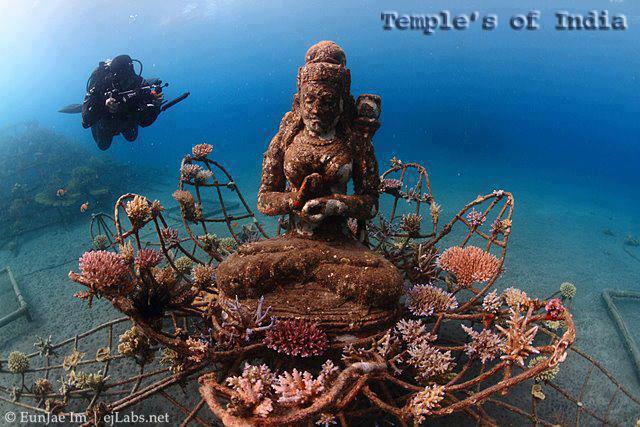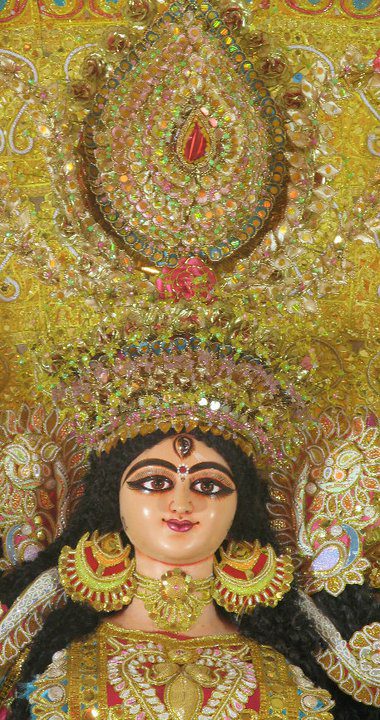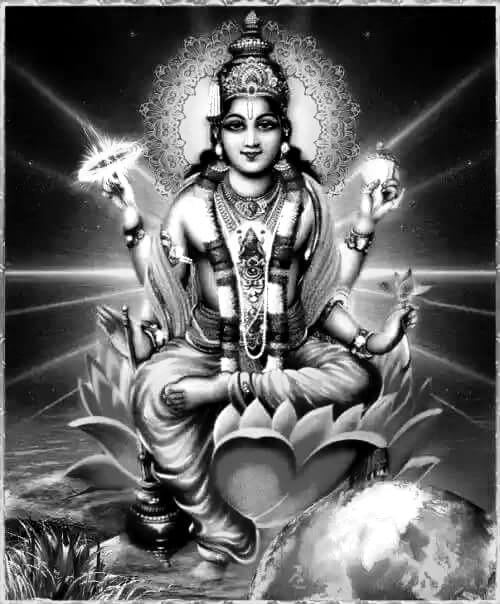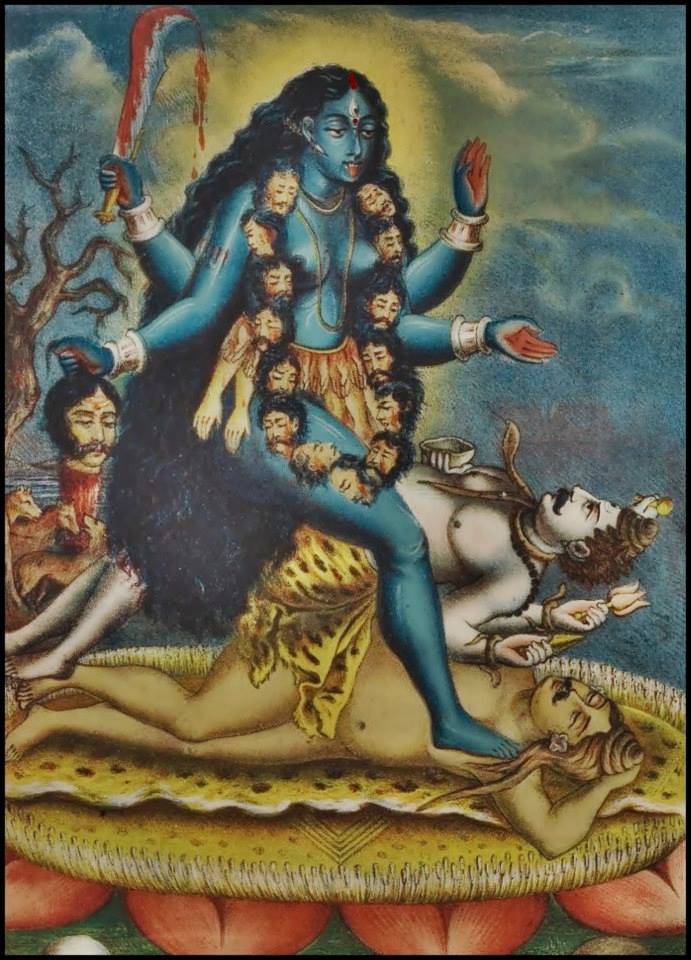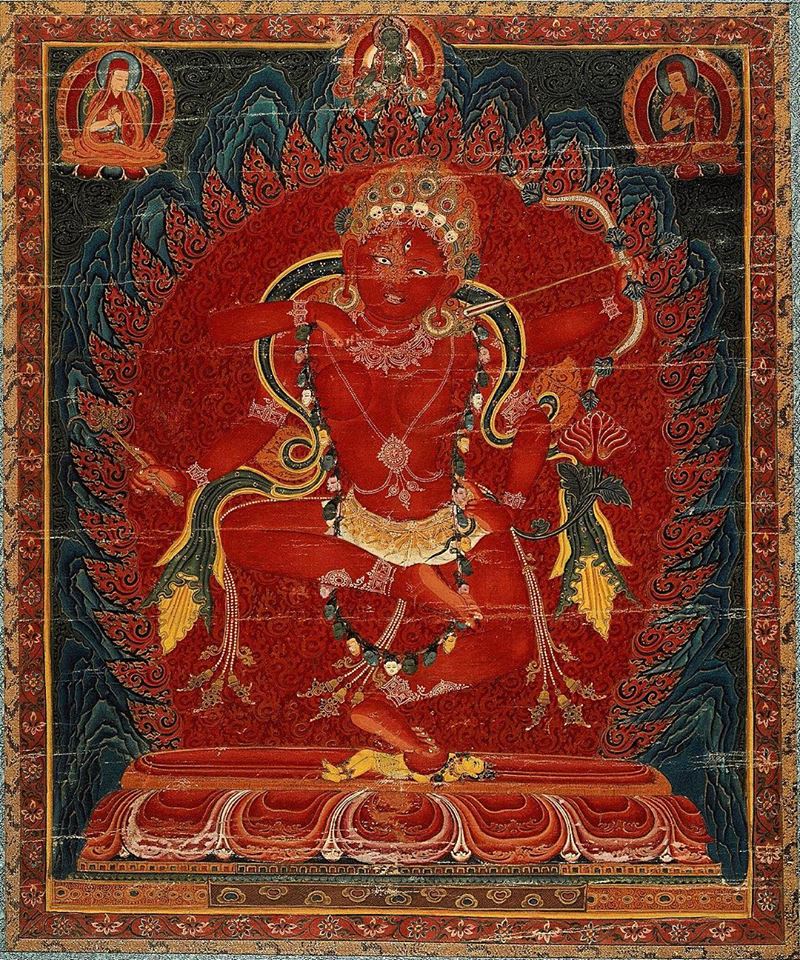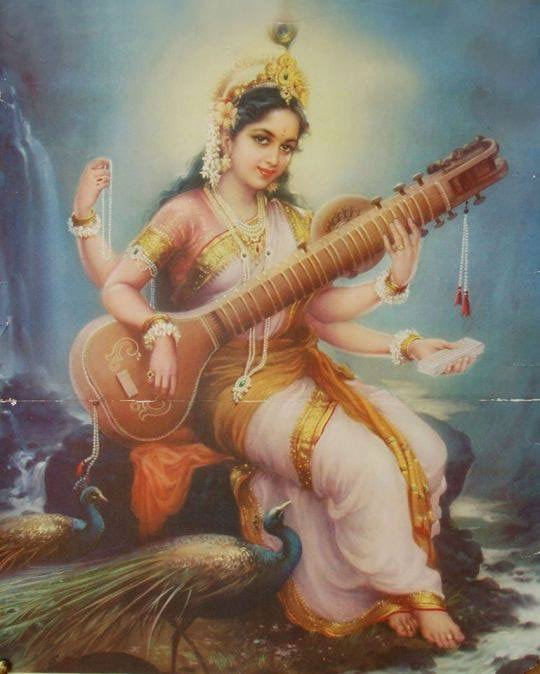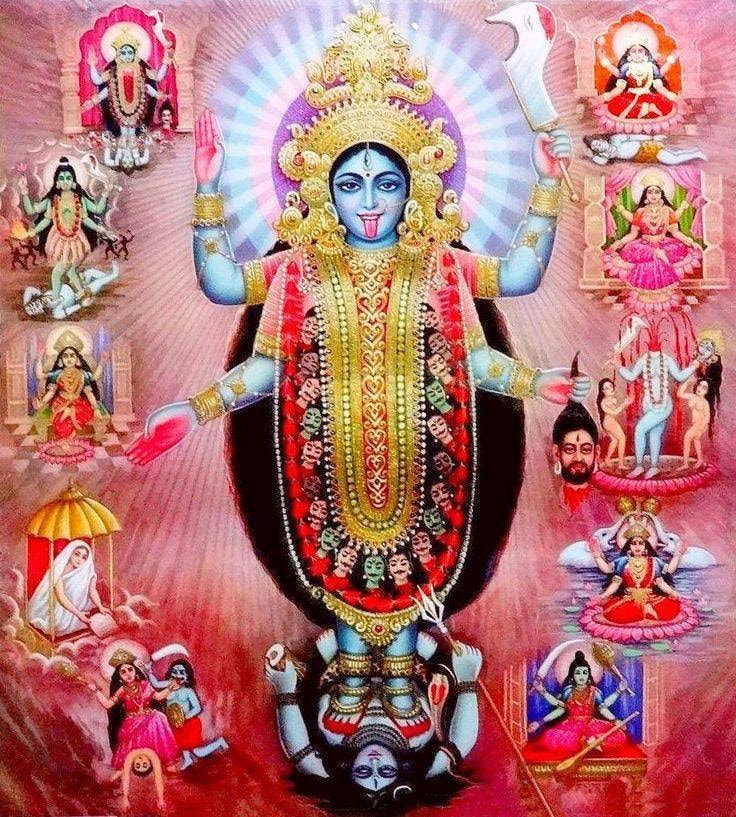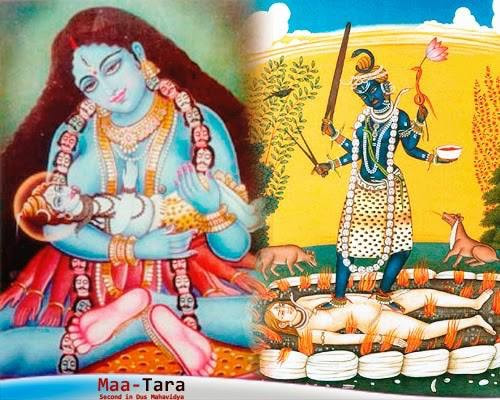
NEELA SARASWATI
or Blue Saraswati is a form of Tara devi in her fierce form.
Tara or Taresi is the goddess that causes bhava tarana, so She is also called Bhava Tarini or crossing the ocean of life. According to Yogini Tantra, Tara is the same as Kali, the embodiment of supreme love. She is also Kamakhya. In Tantric literatures three manifestations of Tara are mentioned: Eka Jata, providing Kaivalya or unity with the Absolute; Ugra Tara, one who provides relief from unforeseen severe meseries and Nila Saraswati, imparting Jnana or knowledge.
Tara is the presiding Goddess of Speech and the Shakti of Hiranya Garba Saura Brahma. As the Sun incarnate, she is the successful owner of Surya Pralaya. The Tara-sadhak becomes well accomplished in all the branches of literature. Traditionally it is held that Vyasa Muni could work on and complete the eighteen Mahapuranas dues to the grace of Goddess Tara.
The aspirants of the Tara cult realize the Purushartha goals of dharma, arta, kama and moksha. Tara is always away from Maya or the Prapancha within it because it is Her own creation. She provides bhoga or bliss initially and then mokhya or salvation.
Tara is surrounded by eight Yoginis: Mahakali, Rudrani, Ugra, Bhima, Ghira, Bhramari, Maharatri and Bhairavi.
Tara, according to Nila Tantra, is iconographically depicted to share the attributes of Goddess Kali.
She stands in the Pratyalidha pose. She is short stature with a protruded belly and Her complexion is dark blue. She has a terrible appearance away from her mild and pretty Sarasawati appearances. She wears tiger skin at Her waist and garland of human-heads at Her neck.
She is of prime youth and adorned with Pancha Mudras. In Her four hands She holds Khadga-sword, Indivara-lotus, Kartika-shear and Kapala-human skull. Her tongue is held out as Kali’s lolling tinge. She wears single braid of matted hair on her head. Tara is three-eyed as she stands on the corpse lying on the burning funeral pyre and ranges her feet, which appears terrible. These are symbolic of Mother Kali, ever ready to remove the darkness of ignorance and passiveness of Her devotees.
Tantric Practice:
Neela Saraswati ritual, Mantra siddhi on Neela Saraswati, Tara Saptakshari mantratantram Neela Sarasawati Sadhana, Tara Yantra and general tantric practices are considered to be for the advanced bhakta who takes guidance from a qualified tantric guru. Tara sadhakas are said to be capable of mastering certain siddhis and whoever completely surrendering before Her with humble motives is taken under Her shelter and supreme grace. The usual vidhya practice in Tantric Tara is that its initiation is given by women. Tara vidhyas use Bhuvaneswari and Tara beejas.
In Tibetian tradition, Neela Saraswati is known as Yang Cheng Mo. The Hindu Mahavidya Goddess Tara figures prominently in Tibetian Bhuddhism. Tara’s appearance in the list of Mahavidyas can probably be explained by the religious communication between Tibet and Bengal where Mahavidya texts such as Mahabhagavata-purana and Brhaddharma-purana originated. Bengal also gave birth to refined forms of Mother Goddess worship. In Bengal, Tara was an epithet of Kali while Tibetian Buddism had twenty forms of Tara. Of this White and Green Tara was popular.
Neela Saraswati appears a Buddhist yidam in her capacity as an embodiment of virtuous activities pertaining to culture and learning. Yangchengmo is the Goddess for performing arts, especially music. In her musical moment and demeanour, Neela Sarasvati is called Piwa Karpo. Her Chinese Buddhist name is Miao-yin-mu. Sarasvati’s mythology includes purificatory aspect. In this she shares her characteristics with White Tara and also with her Japanese equivalent, Benten or Benzeiten. (see previous posting on Benzeiten)
NEELA SARASWATHI STOTRAM:
Prayer to the Blue Saraswathi
1.
Ghora roope maharave , sarva shathru bhayangari,
Bhakthebhyo varade devi thrahi maam saranagatham.
Help me who surrenders to you ,
Oh Goddess with fierce form and great sound,
Who is fearful to all the enemies ,
And who blesses all her devotees.
2.
Surasurarchithe devi, sidha Gandharva sevithe,
Jadya papa hare devi, thrahi maam saranagatham.
Help me who surrenders to you,
Oh Goddess worshipped by devas and asuras,
Who is served by Sidhas and Gandarwas,
And who destroys all accumulated sin.
3.
Jatajuta samayukthe lola jihwantha karini,
Drutha budhikare devi, thrahi maam saranagatham.
Help me who surrenders to you,
Who is with tied matted hair,
Who ends darkness created by unstable toungue,
And who makes our brain work very fast.
4.
Soumya krodha dhare roope , chanda munda namosthuthe,
Srushti roope namasthubhyam, thrahi maam saranagatham.
Help me who surrenders to you,
Who has the form of anger as well as placid nature,
And who is worshipped by Chanda and Munda,
My salutations to her who has form of creation.
5.
Jadaanaam jadathaam hanthi , bhakthaanaam bhaktha vathsala,Moodathaam hara may devi, thrahi maam saranagatham.
Help me who surrenders to you,
Who destroys idiots as well as idiocy,
And who is very dear to her devotees,
Please destroy my foolishness, oh Goddess.
6.
Vam hroom hroom kamaye devi , bali homa priye nama,
Ugra thare namo nithyam , thrahi maam saranagatham.
Help me who surrenders to you,
Who likes the chant “Vam hroom hroom”,
Salutations to her who likes sacrifices and offerings in fire,
I salute daily the fierce Tara devi.
7.
Budhim dehi, yaso dehi , kavithwam dehi dehi may,
Moodathwam cha harer devi, thrahi maam saranagatham.
Help me who surrenders to you,
Give me wisdom , fame and ability to write poems,
And please destroy the foolishness in me.
8.
Indradhi vilasad dwanda vandhithe karunamayi,
Thare tharathi nadhasye , thrahi maam saranagatham.
Help me who surrenders to you,
Who is saluted by Indra and others as couple ,
Who is merciful , Tara and the lord who rules as Tara.
9.
Idham stotram padesdhyasthu sathatham sradhayonvitha,
Thasya Shathru kshayam yathi Maha pragnaa prajayathe.
If this prayer is read regularly with utmost devotion,
His enemies would be destroyed and he would become greatly learned.
(Translation Sri P.R.Ramachander.)
Yogi Ananda Saraswathi
Mother is the manifestation of Goddess Tara. The name Nila Saraswati itself is a combination of Nila which means blue and also that of Kali, the Rudra Sakti that remains after total dissolution. Coming only next to Mother Kali in the Dashamahavidya list of Tantrik goddesses, Nilasaraswathi’s iconography also comes close to that of Goddess Kali. Now this would be opposed to the same Goddess Saraswati given in the Puranas.
In Tantric literature, one finds three manifestations of Tara such as Eka Jata, Ugra Tara and Nila Saraswathi. Eka Jata is she who provides ‘kaivalya’ or unity with the Absolute; Ugra Tara is she who provides relief from unforeseen severe miseries and Nila Saraswathi is she who imparts jnana to her devotees.
It is said that the sage Vyasha muni accomplished work on the eighteen Mahapuranas by being a Nila Saraswathi sadhak to become all accomplished. Goddess Tara also manifests as Dakshina Kali, Tarini and Ugra Tara standing on a supine image of Lord Siva. Mother is dark blue or blue-black in colour with minimal clothes. She wears a tiger skin, a necklace of corpse’s skull and also a girdle of severed arms. Nilasaraswathi also enjoys blood just like Bhadra Kali. Thus she welcomes blood sacrifice. Worshiped mainly for wealth and poetic skill, She is aggressive and of fearful demeanour. Nilasaraswathi exposes her ability to rescue her devotees from calamities.
DEVI MAHATMYA:
Normally Mother Saraswathi is given a benign form as the Goddess of Learning and Wisdom. Her white colour, spotless character, lotus seat, swan vahana, vina instrument, inkpot with pen and books, all point towards a loving goddess and also that of a life giving river. But as the guardian of the earth, Saraswathi takes the form of Durga, to fight the female demon ‘Drug.’ The word dru or dur also means ‘with difficulty’.
Mother Saraswati is in the trinity of Maha Kali, Maha Lakshmi and Maha Saraswathi. Mother is depicted as eight armed. The dhyana shloka given at the 5th chapter of Mahatmya is: “Wielding in her lotus-hands the bell, trident, plough, conch, pestle, discuss, bow and arrow, her luster is like that of a moon shining in the autumn sky. She is born from the body of Gowri and is the sustaining base of the three worlds.
That Maha saraswathi I worship here who destroyed Sumbha and other asuras”.
It is a stated fact that Mother Devi Nilasaraswathi puts her bhaktas to extreme challenges before she blesses and grants siddhis.
The society of Tantra practitioners know of the ardent path to be taken to Devi Nilasaraswathi. This can also misfire if proper rituals are not observed. There cannot be a better example than the sage Vashista Muni. The great muni was plucked off several times in this sadhana despite his extreme austerities of many years. So he placed a curse on Tara-mantra. Following Vasishta’s seat below the same Shalmali tree known as Mundamalinitala where the sage performed his sadhana, Vamdeva, the Bhairava of Tarapith also worshiped Nilasaraswathi. This seat was also known as ‘panch-mundi-asan’ of the seat of five skulls.
Devi Nilasaraswathi was not without her boons. Her grants were poesy and eloquent. To the worthy bhakta, Mother Nilasaraswathi grants ‘vak-siddhi’ meaning she resides in the tongue of the bhakta and that explains her name. This means that the bhakta acquires the destructive power of speech giving him or her an upper hand in debates and contests of knowledge. But it would be essential for the upasak to stick to strict rules of Truth at all times and should not use Mother Nilasaraswathi to persist his opinions. There is still a dispute if Mahakavi Kalidas was blessed by Mother Kali in person or through Devi Nila Saraswathi. Her centre is the tongue though Tara primarily relates to the navel chakra.
MERU TANTRA
mentions the Sapta Saraswathi as
1. Chintamani Saraswathi,
2. Jnana Saraswathi,
3. Nila Saraswathi,
4. Ghata Saraswathi,
5. Kini Saraswathi,
6. Antariksha Saraswathi and
7. Trikuta Saraswathi.
RIG VEDA:
The three Saraswatis are Matangi, Tara and Vina-Sarasvati. The three are the spouses of Ganesh or Matanga Rishi, Brihaspati the Guru of the Gods or Akshobhya Shiva and Brahmanaspati or Brahma, the Creator. Mantra, Vak or speech itself is Shakti, the Goddess as power.
Mantra is more the primal forms as Matangi-Saraswathi. Vak or speech is more Tara-Saraswathi. Formalised language or Sanskrit is more Veena-Saraswathi. The three Saraswathis are important in Hinduism, and also represent the three wisdoms:
Paravidya – Highest wisdom or Self-knowledge.
Devavidya – Knowledge of the Divinities or the Divine Knowledge. Shastravidya – Knowledge of the Scriptures and Texts, or Science.
Modern or Puranic Saraswathi is known as Vina-Saraswathi, and she is the last and lowest of these manifestations.
MAHAVIDYAS:
In Tantra, there are Siddhavidyas and Paravidyas. Siddhavidyas are forms of mystical powers and perfection, and the Paravidyas are transcendental forms. These are forms of Mahavidyas. Nilasaraswathi is another form of Mahavidya Tara. There are separate dhyana shlokas and mantras for her worship in Tantrasara.
BRIHAD NILA TANTRA:
This Tantra of the Kaula tradition is a source to know more of mother. It contains the Tararahasya, 'Secrets of Tara' of Brahmanda Giri which supplies every information in connection with the worship of Nila Sarasvati. The eleventh chapter of the Tantra describes at length how the Goddess of Wisdom became Nila or blue. The Tantra is written in the form of a dialogue in which Mahakalabhairava appears as the speaker and Mahakali as the listener. In this Tantra the Devi requests Bhairava to reveal the Nilatantra as promised at the time the Kalitantra was revealed. The Bhairava redeems the promise and declares that the Tantra which he is to reveal should be duly preserved and concealed, as that leads to many blessings.
It first deals with Nila-Saraswati-the Sapphire Blue Saraswathi. Here she is Brahma-Shakti or spouse of the Supreme Deity. Lord Dattatreya is the patron guru of the Natha tradition, the other aspects being Vishnu and Mahesh. We are not going to indulge on the Buddhist Tara here. Other names given here are Aniruruddha Saraswathi, Ugra Tara and Tarini. They are links between the White Saraswathi and Nilasaraswathi pointing to the Shakti of the Alphabet, the Matrika Shakti.
Mantra, words, music are considered to be the very source of the cosmos, so Nilasaraswathi has an important role in Tantrik cosmology. As Matrika Shakti, She deludes the entire human race with Her Maya of letters, and words. This has been expressed in a Tantrik form. It is apt to say that Maya reaches the human mind through the medium of words also. Thus the tantric role of Nilasaraswathi is justified. Her mantra is described as Siddha-Vidhya, the cause of Maya. Her bija mantra is ‘Aim’.
TODALA TANTRA;
Daily puja of Nila Saraswathi is given in Todala Tantra, The Magic of Kali. It is done in isolated places including cremation grounds. Therefore Nilasaraswathi is bonded with Lord Siva. She is surrounded by jackals and known as Smasana Bhairavi also. There are no rules as to time. In the Maha China Krama, which is Vamachara or left hand tantra, the rule is essentially 'svecchachara' or acting according to one’s will. Meat, wine and sexual union is prominent. This is also given in Mundamala Tantra Tara associated with blood. Partners recite Tara Mantra mentally and there is no external worship as such. The conjunction of yoni and lingam is the essence of the ritual.
Hara Hara Mahadeva
Yogi Ananda Saraswathi.
Tara is the second of the Mahavidyas coming next to Goddess Kali. As Vidya, She is the Wisdom Goddess. Hindu Tara is associated with cremation. She is also known as Kalika, Ugra-kali, Mahakali and Bhadra-kali. ‘Tara’ means star that is perpetually beautiful. Tara closely resembles Kali in appearance and certain attributes displaying saumya – gentle and urga –fierce aspects. Indeed Goddess Kali and Tara were in prominence in the Tantric tradition both in Hinduism and Tibetian Buddhism even before Mahavidya emerged as a cult.
Tara is as potent as Goddess Kali. She is also figured in Jainism. Thus in Hinduism, Jainism and Tibetian Buddhism, Tara, the Blue Goddess, is the Saviouress who helps us overcome our difficult situations and also helps us transcend them. Tara’s name comes from the root which means to carry. As ‘Samsara-tarini’ she aids to cross the tides of stormy sea of troubles and turmoils of life. She is the Tarini, the deliverer or savior, guiding bhaktas towards salvation. In summary Mother Tara is the deity of accomplishments.
She takes many other names too. As Smasana bhairavi, she is the terrible one of the cremation ground; Jalesvari, Mistress of the rain; Jagaddhatri, world nurse; Prthivi, earth; Vasudha, earth; Vrksmadhyani, she who dwells in trees; Sarvavamayi, she who creates everything; Samsaratarini, She who carries across the ocean of samsara.
It can be said that Goddess Tara does not figure prominently in the Hindu tradition. She seems to have a central and ancient place in Tibetian Buddhism. Her appearance in the list of Mahavidyas can probably be explained by the religious communication between Tibet and Bengal. The latter is where Mahavidya texts originated such as Mahabhagavata-purana and Brhaddharma-purana were written. In Bengal, Tara was an epithet of Kali. Tara was thus understood to be much a Hindu and Buddhist God.
SARASWATI-TARA:
Tara is the ‘sabda-shakti’ or power of Sound. She is sometimes equated to Goddess Saraswathi, the Goddess of Learning and associated with speaking prowess, perception and knowledge. Tara is thus referred to as Neela Saraswathi seated on a lotus. ‘Neela’ means blue. She also controls breath, manifesting in primodial sound of life. As Tarini, she is the carrier of knowledge conveyed through sound of speech. Tara is the un-manifest speech that resides in breath and consciousness. She is the feminine form of ‘Aum’. She is also in the Third Eye or Ajna chakra. Her location in the human body is the Manipura chakra or navel centre.
BUDDHISM:
In contrast to the Buddhist Tara who is described as a benevolent, compassionate, gentle and spirited young woman, eager to help and to protect, Tara as Mahavidya is a rather fearsome goddess striking terror. She is also moody and harmful. But at times, Tara-Mahavidya can also be benevolent and compassionate.
According to Tibetan Buddhist tradition, Tara emanated from the tear of Avalokiteshvara. Once Avalokiteshvara liberated all beings from the lower realms and an instant later saw that the lower realms were again filled with suffering beings. Saddened, a tear fell from his eye and from it sprang Green Tara. Both Avalok-iteshvara and Tara embody the principle of compassion, one of the three main aspects of enlightened mind: compassion, wisdom and power.
Kwan Yin is generally explained as a Chinese feminine equivalent of Avalokiteshvara, who manifested to help all those suffering on earth. Thus Tara is understood to be essence of Compassion. She is seen in Tibetian Buddhism as a compassionate savior who rescues devotees from peril. Both Amitabha and Avalokistesvara are renowned for their great compassion and Tara fits into this family.
Like Durga, Tara is often said to rescue her bhaktas from desperate predicaments. Folk stories and legends show her typically appearing at the requests of her devotees to rescue them from jaws of sufferings. Tara is approached as one who protects, preserves and saves life. But Tibetian legends affirm that Tara is Tibetian connected to Tibetian royal line; a historical or legendary queen and mother.
BRIHAD NILA TANTRA:
As the second of the Mahavidyas, Tara, while known to the West through her Tibetian manifestations, occupies an important position in the Hindu Tantrik pantheon. In Brihad Nila Tantra of the Kaula tradition she is Nila Sarasvati - the Sapphire Blue Sarasvati. She is the Brahma-Shakti, or spouse of the Supreme Deity in his Creative aspect. While attempts are made to separate the Hindu from the Tibetan Tara, one cannot doubt that she is the same Shakti. In Hindu Tantrarajatantra, where Her mantra is given as ‘Om Tare Tuttare Ture Svaha’ is identical to the Tibetan version. Here Tara takes her form as Kurukulla and the reference is to the same Devi.
Mention has to be made of Matrika Shakti. The Brihad Nila Tantra and Devirahasya mentions other forms such as Nilasarasvati, Aniruddha Sarasvati, Ugra Tara, Tarini. Nila Sarasvati and the Tibetian White Saraswathi give the same fruits of worshipping Her. It also points to the Goddess being Shakti of the Letters of the Alphabet, the Matrika Shakti. As Matrika Shakti She deludes the entire human race with Her Maya of letters, and words. This has been expressed in a Tantrik form. Her mantra is described as a Siddha-Vidya. She has an important role in Tantrik cosmology because mantra, words, music are considered to be the very source of the cosmos.
KALI – TARA:
Between Kali and Tara there are some similarities as also some differences. As said earlier, Tara’s physical appearance resembles that of Kali. Like Kali, she has three bright red eyes; has four hands holding sword or head chopper, a scissors, a severed head and a lotus; wears the garland of skulls; is richly is bejeweled and has snakes for ornaments; dances on a corpse. Both Kali and Tara are strongly associated with death and dissolution; both stand upon inert male figure. And, both are associated with Shiva. Brahaddharma purana mentions Tara as representing time, just as does Kali.
Whereas Kali is the power of time -kala that inexorably causes all created things to perish, Tara is associated with fire, and particularly the fires of the cremation ground.
There are also differences in the depiction of the two goddesses. Tara's complexion is blue whereas Kali's can be black or deep blue. Tara holds a bowl made from a scull in one hand, a pair of scissors in another, a blue lotus in the third hand and an axe in the fourth.
The scissors and sword in the hands of Tara are tools to remove the ego, the sense of mistaken identity that defines, limits, and binds. They are not weapons of death and destruction. Tara is draped in tiger skin around her waist; and is not naked unlike Kali who symbolizes absolute freedom. Unlike Kali, whose hair flows loose and wild, Tara’s hair of tawny color is carefully bunched into a topknot or jata. Whereas Kali’s hair represents absolute freedom from constraint, Tara’s is a symbol of yogic asceticism and restraint. Kali represents the highest form of wisdom or liberating knowledge; and Tara is related to the discipline of yogic practices.
MYTHOLOGY:
The mythological origin of Tara is in Amrit Manthan. Both Devas and Asuras participated in the churning exercise and both wanted it. However, Amrit is not the only thing that came out of the water. Many invaluable gems and stones and medicines were also yielded by the ocean. Likewise the ocean also yielded poison. The poison was so strong that if it fell on the ground then all Life would be wiped out. Fearing such devastation the Asuras and Devas approached Lord Shiva for help. He promised that He would drink the poison and save the world from destruction.
As the Lord drank the poison He was filled with pain and his throat blue and earning him the epithet Nilakantha. His entire body was burning from inside. When the pain became unbearable, Tara appeared and took Shiva on her lap. She suckled him. The milk from her breasts counteracted the poison. The Lord recovered. This story forms a prominent depiction of Hindu Tara. The other story where the Lord is in an infant status is when Ma Kali was on a rampage. Siva becomes an infant and Kali's maternal instinct comes to the fore. She silences herself to nurses the infant Shiva.
TARAPITH:
Pursuant to Dakshan’s yagna and Sati entering agni, Lord Vishnu had to step in to stop Siva from destroying the world. He uses the Sudarshan Chakra to cut Sati’s body into 52 pieces. With the body gone, Lord Siva regained His composure and the world was saved. Some part are said to have fallen in the ocean and some on land. These had become holy places. Tara is one of Shakti’s incarnations; it is believed that She is the third eye of Mother Shakti. Tarapith is where Tara is worshipped. However, it is sometimes debated if Tarapith is indeed a Shaktipith.
Notwithstanding, Tarapith is a highly important Tantric site for Bengali Shaktas. Blood sacrifice is a daily occurance here. It is covered abundantly by Garlands of flowers. Tara image here is unique. Made of silver metal, Tara is depicted with Her lower half of the face covered in blood. She has four arms wearing a garland of skulls and a protruding tongue. Her image is wrapped in a red sari decked in marigold garlands with a silver umbrella above her head. Her feet are in front of Her image in a severed fashion as if they had been cut off. There is exposure if a leg bone. Apparently the murti is in fact a composite one which covers the actual ‘self-formed’ Deity; one said to be worshipped for 5,000 years by the Pujaris at the temple. In former times known as Chandipur. It is vague in its depiction of a mother suckling a child implying Tara breast feeding the infant Siva. Not many get to see this deity as getting access to the sanctum sanctorum is no easy feat.
Tarapith is also famous for Bama Khepa, said to be the ‘mad saint’ who worshipped in the temple and resided in the cremation grounds practicing and perfecting yoga and tantric art under the guidance of another famous master called Kailashpathi Baba. Bama-khepa means the left handed path of Tantric worship. It is said that Tara gave her vision and breast fed Bama Khepa.
SMASHAN TARA:
Cremation grounds are seen to be polluting, most; thus Indian smashans are located far from the center of town. However both the Tarapith mandir and smashan are within the vicinity of the town centre. It is common belief that Goddess Tara’s footprints are preserved in the smashan. The smashan contains within it permanent huts and residences amidst banyan trees for sadhus and tantrikas. Dogs are a common sight. Trishuls decorated with marigold garland and skulls are placed in the entrance.
At the midnight hour, the aghori sits alone in the smashan.
To his this is undeniably a sacred site. He is naked or digambra, fearless and unashamed. He performs his rituals and chants his mantra. He gazes in wonder at the resplendent form of his beloved goddess, Shaman Tara – Tara of the Cremation Grounds. Maa, in her deep blue colour, three eyes and four arms is said to arise amidst the blazing heat of the funeral pyre standing upon fire consumed skeleton of a male corpse like a warrior. Her right foot presses upon the breast which is the place of desire and Maa’s left foot pressing upon the skeleton’s legs, the place of worldly ambitions. The roaring funeral pyre is the fire at the end of time – kalagni, the ultimate conflagration of the universe. Her body is formed of pure light; she is unrestrained, wild, terrifying and fearless. Her beautiful midnight blue complexion represents her immutable and indestructible nature.
She is the colour of space. She is vast and measureless like the night sky beyond the concepts or qualitie – nirguna. Her breasts are large pot shaped – ghatastani, symbolizing spiritual nourishment to her bhaktas. Lambodari – her stomach is full and rounded, symbolizing her hunger for the corpses of selflessness. She is as naked and sky-clad – digambra symbolizing her freedom from the veils of emotional defilements. The girdle of eight blood dripping forearms symbolize her severance of all action and karmas and eight worldly dharmas of loss and gain, praise and blame, pleasure and pain, ignominy and fame. Her long hair is disheveled and hangs freely to symbolize her untied appearances and revel her unconditional freedom. If you seek, Maa Tara is is there.





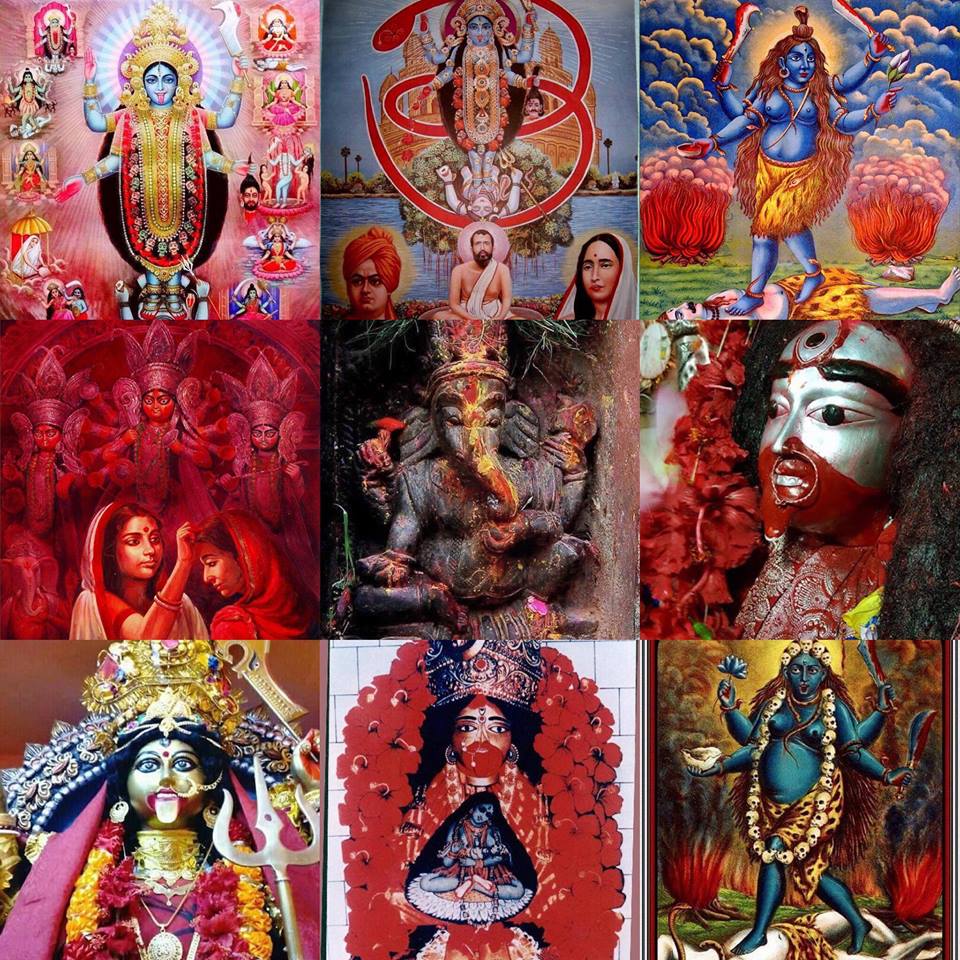
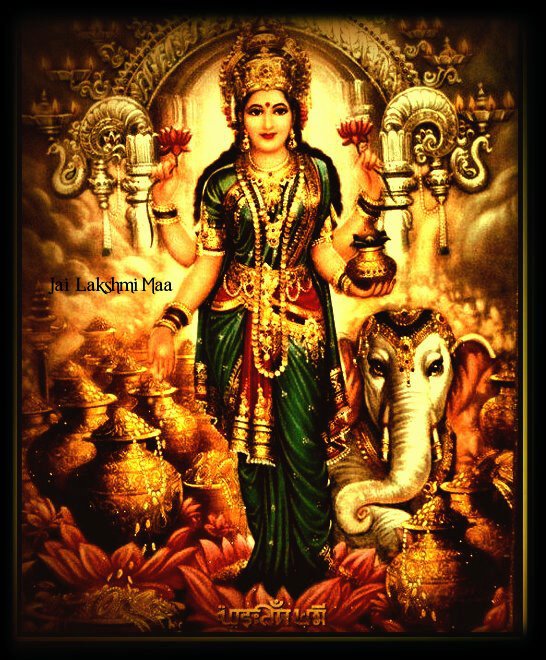

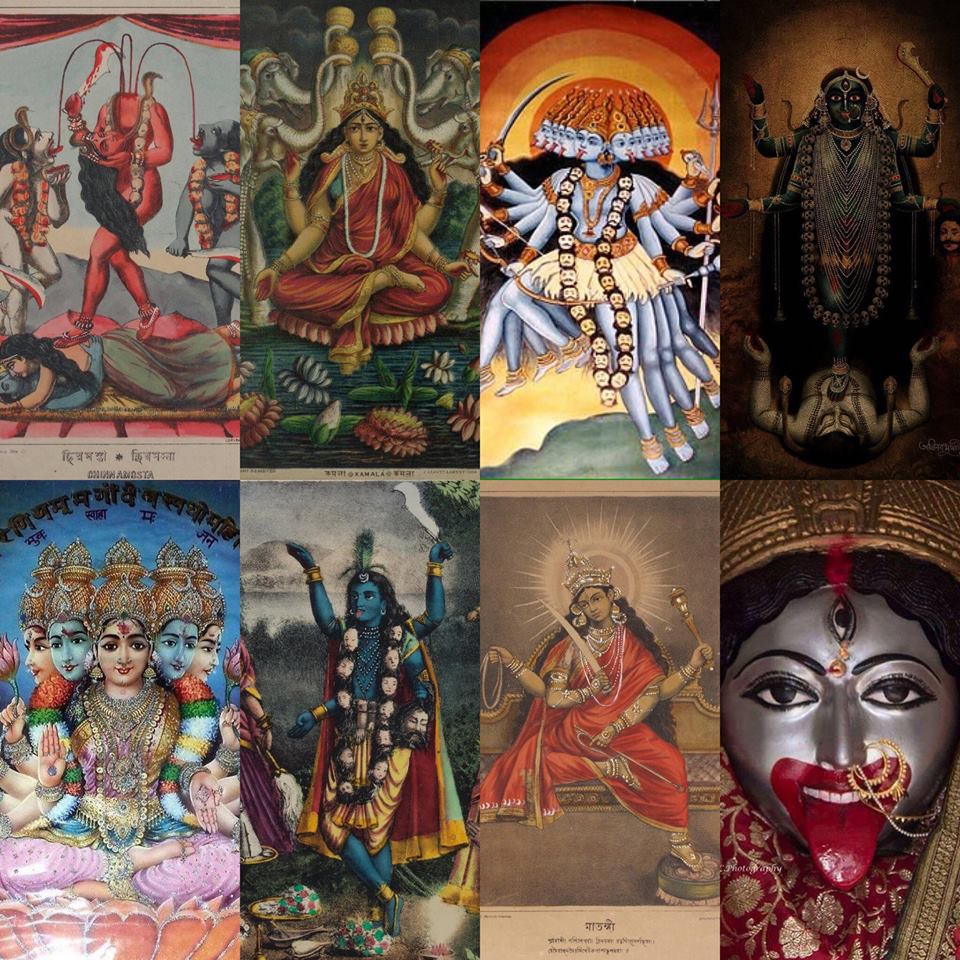
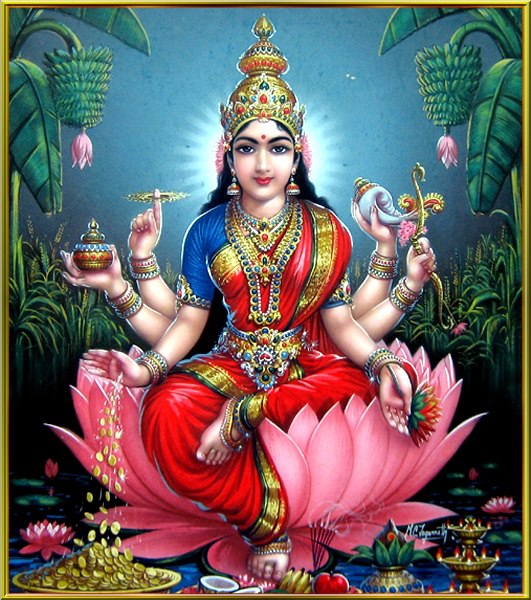



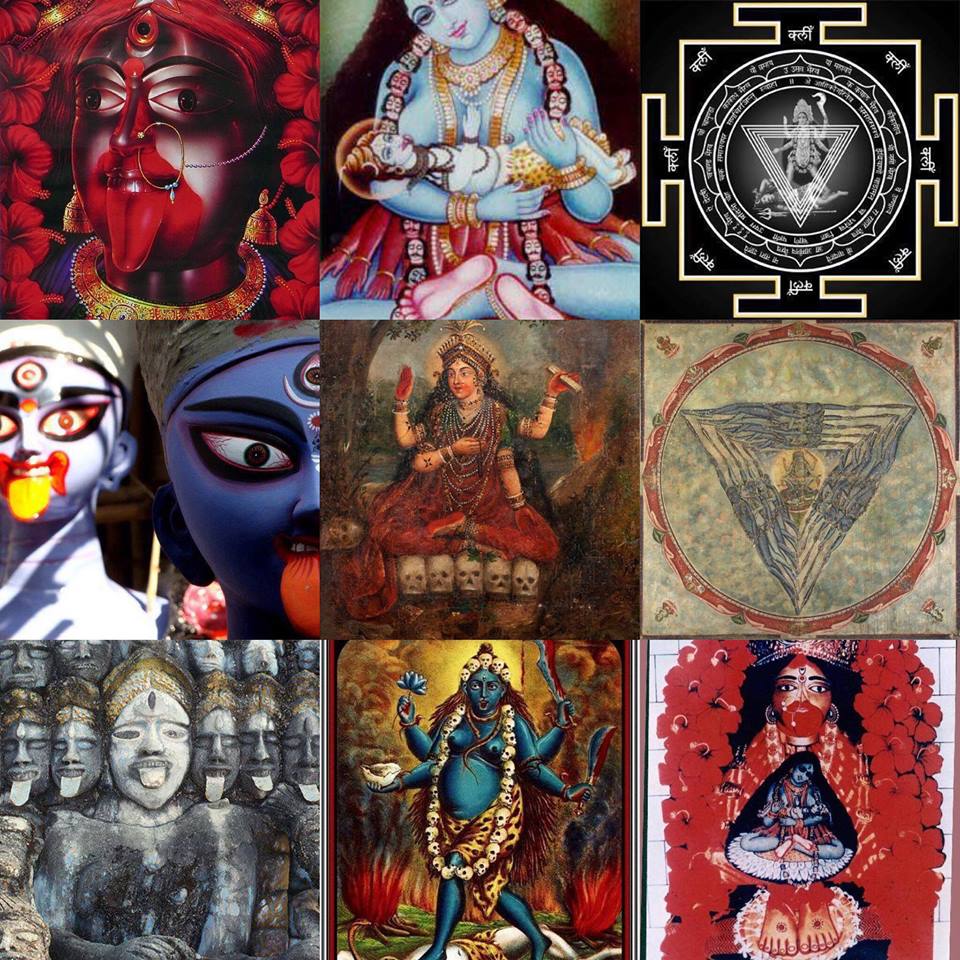


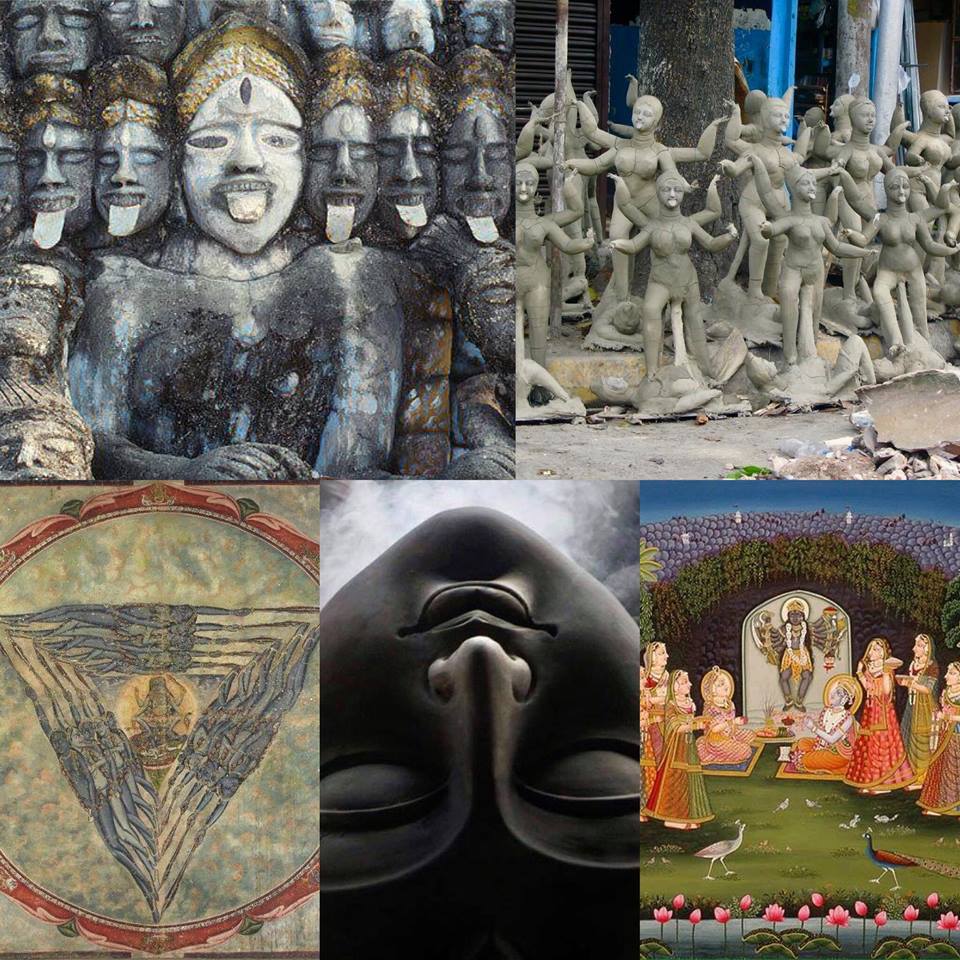







 RSS Feed
RSS Feed























